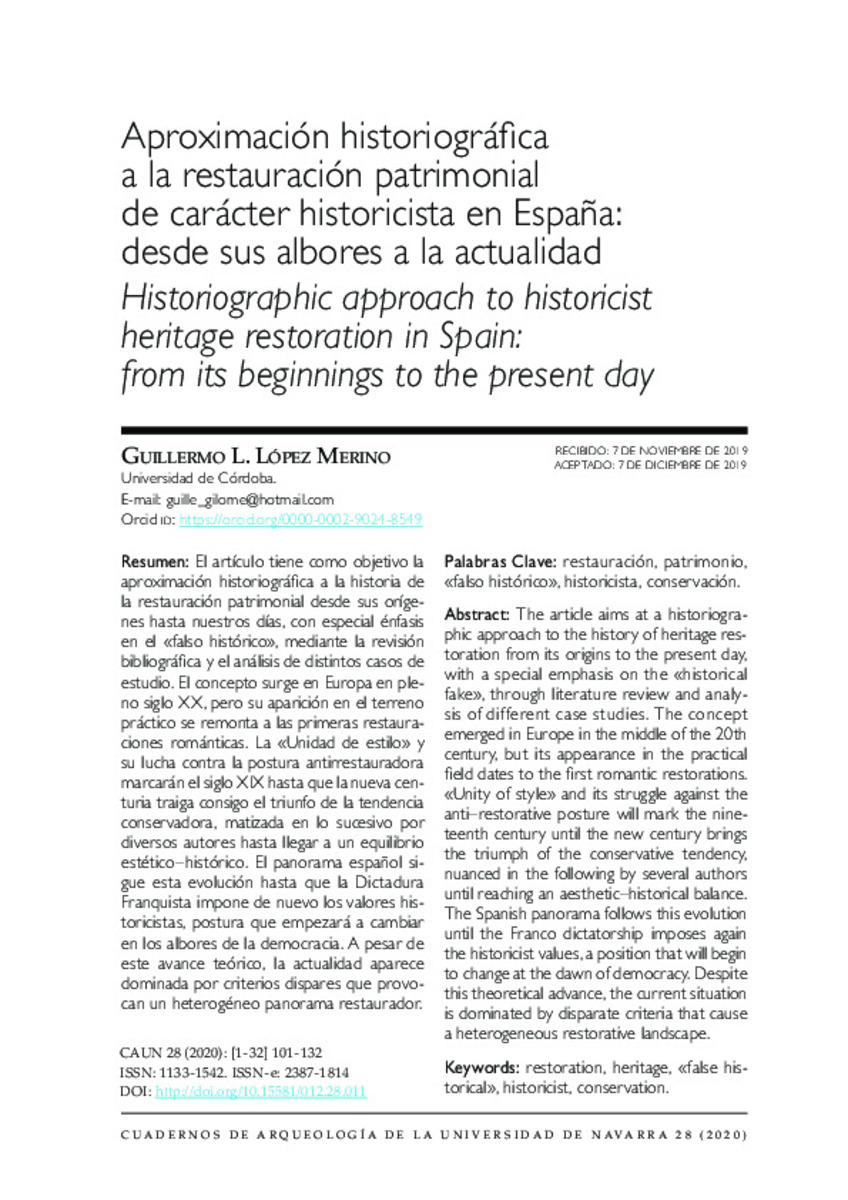Full metadata record
| DC Field | Value | Language |
|---|---|---|
| dc.creator | López-Merino, G.L. (Guillermo L.) | - |
| dc.date.accessioned | 2020-01-29 | - |
| dc.date.accessioned | 2021-06-23T12:51:16Z | - |
| dc.date.available | 2021-06-23T12:51:16Z | - |
| dc.date.issued | 2020 | - |
| dc.identifier.citation | López-Merino, G.L. (Guillermo L.). "Aproximación historiográfica a la restauración patrimonial de carácter historicista en España: desde sus albores a la actualidad". Cuadernos de Arqueología de la Universidad de Navarra. 28, 2020, 101 - 132 | es |
| dc.identifier.issn | 2387-1814 | - |
| dc.identifier.uri | https://hdl.handle.net/10171/60843 | - |
| dc.description.abstract | The article aims at a historiographic approach to the history of heritage restoration from its origins to the present day, with a special emphasis on the «historical fake», through literature review and analysis of different case studies. The concept emerged in Europe in the middle of the 20th century, but its appearance in the practical field dates to the first romantic restorations. «Unity of style» and its struggle against the anti–restorative posture will mark the nineteenth century until the new century brings the triumph of the conservative tendency, nuanced in the following by several authors until reaching an aesthetic–historical balance. The Spanish panorama follows this evolution until the Franco dictatorship imposes again the historicist values, a position that will begin to change at the dawn of democracy. Despite this theoretical advance, the current situation is dominated by disparate criteria that cause a heterogeneous restorative landscape. | en_US |
| dc.description.abstract | El artículo tiene como objetivo la aproximación historiográfica a la historia de la restauración patrimonial desde sus orígenes hasta nuestros días, con especial énfasis en el «falso histórico», mediante la revisión bibliográfica y el análisis de distintos casos de estudio. El concepto surge en Europa en pleno siglo XX, pero su aparición en el terreno práctico se remonta a las primeras restauraciones románticas. La «Unidad de estilo» y su lucha contra la postura antirrestauradora marcarán el siglo XIX hasta que la nueva centuria traiga consigo el triunfo de la tendencia conservadora, matizada en lo sucesivo por diversos autores hasta llegar a un equilibrio estético–histórico. El panorama español sigue esta evolución hasta que la Dictadura Franquista impone de nuevo los valores historicistas, postura que empezará a cambiar en los albores de la democracia. A pesar de este avance teórico, la actualidad aparece dominada por criterios dispares que provocan un heterogéneo panorama restaurador. | es_ES |
| dc.language.iso | spa | - |
| dc.publisher | Servicio de Publicaciones de la Universidad de Navarra | es_ES |
| dc.rights | info:eu-repo/semantics/openAccess | es_ES |
| dc.subject | restauración | - |
| dc.subject | patrimonio | - |
| dc.subject | “falso histórico” | - |
| dc.subject | historicista | - |
| dc.subject | conservación | - |
| dc.title | Aproximación historiográfica a la restauración patrimonial de carácter historicista en España: desde sus albores a la actualidad | es_ES |
| dc.title.alternative | Historiographic approach to historicist heritage restoration in Spain: from its beginnings to the present day | en_US |
| dc.type | info:eu-repo/semantics/article | es_ES |
| dc.identifier.doi | 10.15581/012.28.011 | - |
| dadun.citation.endingPage | 132 | - |
| dadun.citation.publicationName | Cuadernos de Arqueología de la Universidad de Navarra | - |
| dadun.citation.startingPage | 101 | - |
| dadun.citation.volume | 28 | - |
Files in This Item:
Statistics and impact
Items in Dadun are protected by copyright, with all rights reserved, unless otherwise indicated.






